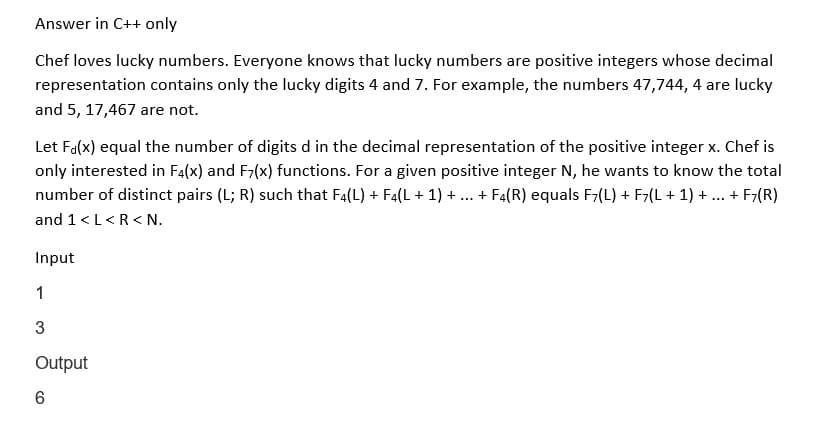Answer in C++ only Chef loves lucky numbers. Everyone knows that lucky numbers are positive integers whose decimal representation contains only the lucky digits 4 and 7. For example, the numbers 47,744, 4 are lucky and 5, 17,467 are not. Let F(x) equal the number of digits d in the decimal representation of the positive integer x. Chef is only interested in F4(x) and F7(x) functions. For a given positive integer N, he wants to know the total number of distinct pairs (L; R) such that F4(L) + F4(L + 1) + ... + F4(R) equals F7(L) + F7(L + 1) + ... + F7(R) and 1
Answer in C++ only Chef loves lucky numbers. Everyone knows that lucky numbers are positive integers whose decimal representation contains only the lucky digits 4 and 7. For example, the numbers 47,744, 4 are lucky and 5, 17,467 are not. Let F(x) equal the number of digits d in the decimal representation of the positive integer x. Chef is only interested in F4(x) and F7(x) functions. For a given positive integer N, he wants to know the total number of distinct pairs (L; R) such that F4(L) + F4(L + 1) + ... + F4(R) equals F7(L) + F7(L + 1) + ... + F7(R) and 1
Computer Networking: A Top-Down Approach (7th Edition)
7th Edition
ISBN:9780133594140
Author:James Kurose, Keith Ross
Publisher:James Kurose, Keith Ross
Chapter1: Computer Networks And The Internet
Section: Chapter Questions
Problem R1RQ: What is the difference between a host and an end system? List several different types of end...
Related questions
Question

Transcribed Image Text:Answer in C++ only
Chef loves lucky numbers. Everyone knows that lucky numbers are positive integers whose decimal
representation contains only the lucky digits 4 and 7. For example, the numbers 47,744, 4 are lucky
and 5, 17,467 are not.
Let F(x) equal the number of digits d in the decimal representation of the positive integer x. Chef is
only interested in F4(x) and F7(x) functions. For a given positive integer N, he wants to know the total
number of distinct pairs (L; R) such that F4(L) + F4(L + 1) + ... + F4(R) equals F7(L) + F7(L + 1) + + F7(R)
and 1 <L<R<N.
Input
1
3
Output
6
Expert Solution
This question has been solved!
Explore an expertly crafted, step-by-step solution for a thorough understanding of key concepts.
Step by step
Solved in 5 steps with 2 images

Recommended textbooks for you

Computer Networking: A Top-Down Approach (7th Edi…
Computer Engineering
ISBN:
9780133594140
Author:
James Kurose, Keith Ross
Publisher:
PEARSON

Computer Organization and Design MIPS Edition, Fi…
Computer Engineering
ISBN:
9780124077263
Author:
David A. Patterson, John L. Hennessy
Publisher:
Elsevier Science

Network+ Guide to Networks (MindTap Course List)
Computer Engineering
ISBN:
9781337569330
Author:
Jill West, Tamara Dean, Jean Andrews
Publisher:
Cengage Learning

Computer Networking: A Top-Down Approach (7th Edi…
Computer Engineering
ISBN:
9780133594140
Author:
James Kurose, Keith Ross
Publisher:
PEARSON

Computer Organization and Design MIPS Edition, Fi…
Computer Engineering
ISBN:
9780124077263
Author:
David A. Patterson, John L. Hennessy
Publisher:
Elsevier Science

Network+ Guide to Networks (MindTap Course List)
Computer Engineering
ISBN:
9781337569330
Author:
Jill West, Tamara Dean, Jean Andrews
Publisher:
Cengage Learning

Concepts of Database Management
Computer Engineering
ISBN:
9781337093422
Author:
Joy L. Starks, Philip J. Pratt, Mary Z. Last
Publisher:
Cengage Learning

Prelude to Programming
Computer Engineering
ISBN:
9780133750423
Author:
VENIT, Stewart
Publisher:
Pearson Education

Sc Business Data Communications and Networking, T…
Computer Engineering
ISBN:
9781119368830
Author:
FITZGERALD
Publisher:
WILEY